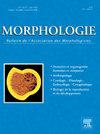产前浅肌腱神经系统图像
Q3 Medicine
引用次数: 0
摘要
浅表肌腱神经系统(SMAS)是一个首字母缩略词,描述了面部皮下锚定的三维(3D)纤维-脂肪-肌肉组织网络,连接到模拟肌肉。SMAS转移,分布和加强模拟面部肌肉收缩到皮肤决定模拟表情和面部褶皱的形成。本研究的目的是对产前SMAS(前SMAS)发育的组织形态学分析,以类比成人SMAS的类型。方法对来自华盛顿特区历史悠久的Carnegie Collection和Witten/Herdecke大学历史组织学Collection的不同染色的31个胚胎和胎儿的组织学序列切片(n = 7300)进行分析。在显微镜下研究了所有标本头部和颈部的面部模拟肌肉的发生、sma前的发育和时间变化。结果描述了3种前smas类型。前SMAS I型由间充质SMAS组成,血管密度低,结构变化最小,覆盖额部和枕部。Pre-SMAS II型由间充质SMAS组成,血管密度低,结构变化最小,覆盖眼周区、预备区和鼻区。Pre-SMAS III型包括具有肌肉整合和结缔组织重塑的SMAS,覆盖腮腺区、口周区和颈区。成人的SMAS结构在预备区、额区、枕区、眼周区、颈区和鼻区与前SMAS区没有形态学上的相似性。腮腺区前SMAS结缔组织结构与成人I型SMAS相似。口周肌区smas前显示孤立的肌纤维,它们垂直于皮肤水平排列。直到妊娠22周,皮下面部脂肪组织都检测不到。结论spre - smas组织变形与模拟肌肉发育不同步,但其变化和组织分化与模拟肌肉活动密切相关。因此,提出了以下的个体发生假说:前smas样本的发展遵循“形式追随功能活动”的规律。本文章由计算机程序翻译,如有差异,请以英文原文为准。
Prenatal superficial musculoaponeurotic system anlage
Introduction
The superficial musculoaponeurotic system (SMAS) is an acronym describing a facial subcutaneous anchored three-dimensional (3D) fibro-adipose-muscular tissue network connected to mimic muscles. SMAS transfers, distributes and reinforces mimic facial muscles contractions to the skin determining mimic expression and facial fold formation. The aim of this study was the histomorphological analysis of prenatal SMAS (pre-SMAS) development in analogy to the adult SMAS typology.
Method
Histological serial sections (n = 7300 of 31 embryos and fetuses) of different staining obtained from the historic Carnegie Collection, Washington D.C. and from the Historical Histological Collection, University Witten/Herdecke were analyzed. All specimens head and neck area were investigated microscopically regarding facial mimic muscles genesis, pre-SMAS development and chronological changes.
Results
Three pre-SMAS Types were described. Pre-SMAS Type I consisting of mesenchymal SMAS with low vascularity and minimal structural changes covered Regio Frontalis and Regio Occipitalis. Pre-SMAS Type II consisting of mesenchymal SMAS with low vascularity and minimal structural changes covered Regio Periocularis, Regio Preparotidea and Regio Nasalis. Pre-SMAS Type III consisting of SMAS with muscular integration and connective tissue remodeling covered Regio Parotidea, Regio Perioralis, and Regio Cervicalis. There were no morphological similarities between adult SMAS architecture compared to pre-SMAS anlage in Regio Preparotidea, Regio Frontalis, Regio Occipitalis, Regio Periocularis, Regio Cervical and Regio Nasalis. Regio parotidea pre-SMAS showed analogies in connective tissue architecture to adult type I SMAS. Regio Perioralis pre-SMAS showed isolated muscle fibers, which were aligned perpendicular to the skin level. Subcutaneous facial adipose tissue was undetectable up to the 22nd week of gestation.
Conclusions
Pre-SMAS anlage metamorphosis seems not to emerge synchronously with mimic muscle development, but its changes and tissue differentiation are closely related to mimic muscle activity. Therefore following ontogenetic hypothesis was proposed: the development of pre-SMAS anlage follows the law “form follows functional activity”.
求助全文
通过发布文献求助,成功后即可免费获取论文全文。
去求助
来源期刊

Morphologie
Medicine-Anatomy
CiteScore
2.30
自引率
0.00%
发文量
150
审稿时长
25 days
期刊介绍:
Morphologie est une revue universitaire avec une ouverture médicale qui sa adresse aux enseignants, aux étudiants, aux chercheurs et aux cliniciens en anatomie et en morphologie. Vous y trouverez les développements les plus actuels de votre spécialité, en France comme a international. Le objectif de Morphologie est d?offrir des lectures privilégiées sous forme de revues générales, d?articles originaux, de mises au point didactiques et de revues de la littérature, qui permettront notamment aux enseignants de optimiser leurs cours et aux spécialistes d?enrichir leurs connaissances.
 求助内容:
求助内容: 应助结果提醒方式:
应助结果提醒方式:


